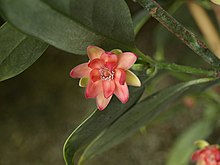| Illicium | |
|---|---|

| |
| Fruits of Illicium verum | |
| Scientific classification | |
| Kingdom: | Plantae |
| Clade: | Tracheophytes |
| Clade: | Angiosperms |
| Order: | Austrobaileyales |
| Family: | Schisandraceae |
| Genus: | Illicium L. |
| Type species | |
| Illicium anisatum | |
| Synonyms | |
| |



Illicium is a genus of flowering plants treated as part of the family Schisandraceae, or alternately as the sole genus of the Illiciaceae. It has a disjunct distribution, with most species native to eastern Asia and several in parts of North America, including the southeastern United States, Mexico, and the Caribbean. General common names include star anise and anisetree. The genus name comes from the Latin illicere ("to allure").
Description
Illicium species are evergreen shrubs and small trees. The leaves are alternately arranged and borne on petioles. The blades are glandular and fragrant. The flowers are solitary. They have few to many tepals in two or three rows, the inner ones like petals and the outer ones often smaller and more like bracts. A few to many stamens and pistils are at the center. The fruit is an aggregate of follicles arranged in a star-shaped whorl. One seed is in each follicle, released when the follicle dehisces. The seed has a thick, oily endosperm.
Biology
These are plants of moist understory, adapted to shady habitat, and some species are so sensitive to light that too much sunlight causes them significant stress, manifesting in chlorosis and necrosis of the leaves.
Uses
Several species are cultivated as ornamental plants for their flowers, foliage, and fragrance, leading to the development of several cultivars. Many taxa can only be grown in low-light situations.
The essential oils of several species are used as flavorings and carminatives; however, the oils of I. anisatum and I. floridanum are toxic. I. verum, the common star anise, is used to flavor food and liquor. Its fruit is a traditional Chinese medicine called bājiǎo huíxiāng (八角茴香), which is used to treat abdominal pain and vomiting.
Diversity
Illicium is a notably difficult genus to taxonomically classify. Many of the currently recognized species lack distinguishing characters, and treatments tend to list many synonyms. Additionally, herbarium material is often poorly preserved or scarce.
As of August 2024, Plants of the World Online accepted these species:
- Illicium angustisepalum A.C.Sm. – South China
- Illicium anisatum L. – Japan, South Korea, Taiwan
- Illicium arborescens Hayata – Taiwan
- Illicium brevistylum A.C.Sm. – China (Guangdong, Guangxi, Hunan, Yunnan)
- Illicium burmanicum E.H.Wilson – China (Yunnan), Myanmar
- Illicium cubense A.C.Sm. – Cuba
- Illicium difengpi B.N.Chang – Guangxi
- Illicium dunnianum Tutcher – South China
- Illicium ekmanii A.C.Sm. – Hispaniola
- Illicium floridanum J.Ellis – United States (Florida, Georgia, Alabama, Mississippi, Louisiana)
- Illicium gansuense Z.F.Bai & Xue L.Chen – North China
- Illicium griffithii Hook.f. & Thomson – Tibet, Bhutan, Arunachal Pradesh
- Illicium guajaibonense (Imkhan.) Judd & J.R.Abbott – Cuba
- Illicium henryi Diels – South China
- Illicium hottense A.Guerrero, Judd & A.B.Morris – Haiti
- Illicium jiadifengpi B.N.Chang – South China
- Illicium lanceolatum A.C.Sm. – South China
- Illicium leiophyllum A.C.Sm. – Hong Kong
- Illicium macranthum A.C.Sm. – Yunnan
- Illicium majus Hook.f. & Thomson – South China, Vietnam, Myanmar
- Illicium merrillianum A.C.Sm. – Yunnan, Myanmar
- Illicium micranthum Dunn – Yunnan
- Illicium modestum A.C.Sm. – Yunnan
- Illicium pachyphyllum A.C.Sm. – China (Guangxi)
- Illicium parviflorum Michx. ex Vent. – yellow anise – United States (Florida, Georgia, South Carolina)
- Illicium parvifolium Merr. – China, Vietnam
- Illicium petelotii A.C.Sm. – Yunnan, Vietnam
- Illicium philippinense Merr. – Philippines, Taiwan
- Illicium ridleyanum A.C.Sm. – Peninsular Malaysia
- Illicium simonsii Maxim. – South China, Assam, Myanmar
- Illicium stapfii Merr. – Borneo
- Illicium sumatranum A.C.Sm. – Sumatra
- Illicium tashiroi Maxim. – Taiwan, Ryukyu Islands
- Illicium tenuifolium (Ridl.) A.C.Sm. – Vietnam
- Illicium ternstroemioides A.C.Sm. – China (Fujian, Hainan)
- Illicium tsaii A.C.Sm. – Yunnan
- Illicium verum Hook.f. – star anise, Chinese star-anise, staranise tree – Guangxi
- Illicium viridiflorum Yahara, A.Nagah. & Tagane – Vietnam
- Illicium wardii A.C.Sm. – Yunnan, Myanmar
References
- ^ "Illicium L." Plants of the World Online. Board of Trustees of the Royal Botanic Gardens, Kew. 2017. Retrieved 13 March 2021.
- ^ Illicium. Integrated Taxonomic Information System (ITIS).
- Watson, L. and M. J. Dallwitz. 1992 onwards. Illiciaceae Van Tiegh. Archived 2007-01-03 at the Wayback Machine The Families of Flowering Plants. Version: 19 August 2013.
- Oh, I. C., et al. (2003). Evolution of Illicium (Illiciaceae): mapping morphological characters on the molecular tree. Plant Systematics and Evolution 240(1-4), 175–209.
- ^ Illicium. Flora of North America.
- ^ Illiciaceae. Flora of North America.
- ^ Griffin, J. J., et al. (2004). Photosynthesis, chlorophyll fluorescence, and carbohydrate content of Illicium taxa grown under varied irradiance. Journal of the American Society for Horticultural Science 129(1), 46–53.
- Ashburn, D. Illicium belongs in Southern gardens. Archived 2013-09-08 at the Wayback Machine Cooperative Extension. North Carolina State University. 2006.
- Morris, Ashley B.; Bell, Charles D.; Clayton, Joshua W.; Judd, Walter S.; Soltis, Douglas E.; Soltis, Pamela S. (2007). "Phylogeny and Divergence Time Estimation in Illicium with Implications for New World Biogeography". Systematic Botany. 32 (2): 236–249. doi:10.1600/036364407781179734. S2CID 86383852.
- Biota of North America Program 2013 county distribution map, Illicium floridanum
- Biota of North America Program, 2013 county distribution map, Illicium parviflorum
Further reading
- Carlquist, S. and E. L. Schneider. (2002). Vessels of Illicium (Illiciaceae): range of pit membrane remnant presence in perforations and other vessel details. International Journal of Plant Sciences 163(5), 755–63.
- Williams, J. H. and W. E. Friedman. (2004). The four-celled female gametophyte of Illicium (Illiciaceae; Austrobaileyales): implications for understanding the origin and early evolution of monocots, eumagnoliids, and eudicots. American Journal of Botany 91(3), 332–51.